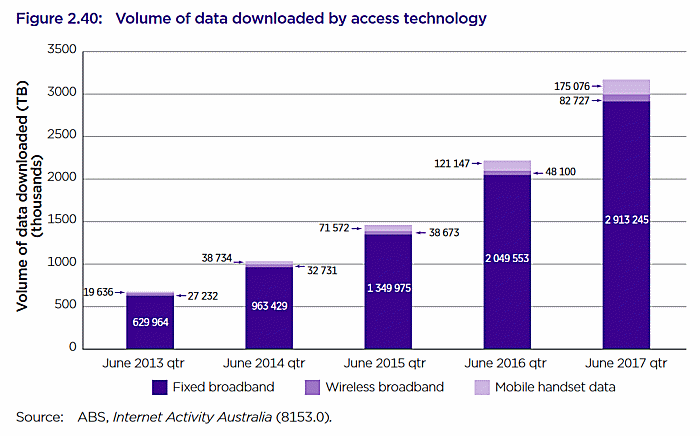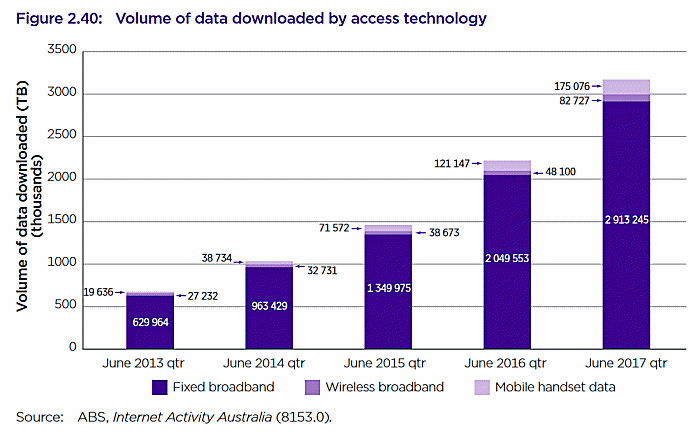Among other interesting facts, figures and statistics, a report published this week shows Australians' appetite for bandwidth is being somewhat satiated by a significant increase in the number of ISPs offering unlimited data broadband plans.
 Graph via ACCC
Graph via ACCC
In its report, the Australian Competition and Consumer Commission says the number of internet subscribers in Australia exceeded 40 million as at 30 June 2017. With the nation's population nudging 25 million, many Australians have multiple subscriptions e.g. fixed line or wireless + mobile broadband. In fact, mobile handsets accounted for almost two-thirds of broadband subscriptions.
What fixed line broadband lacks in subscription numbers compared to mobile, it more than makes up for in data downloads. The Commission noted overall download volumes continue to increase, jumping 42 per cent between June 2016 and June 2017 for fixed line broadband from 2050 petabytes (PB) to 2913 PB (a petabyte is approximately one million gigabytes.) Fixed networks accounted for around 92 per cent of all downloads.
Download volume via mobile handsets increased from 121 PB to 175 PB, while wireless broadband services (including fixed wireless) saw almost 72 per cent growth in download volume over the year from 48 PB to 83 PB.
"Continued growth in the consumption of content streaming services, social media and other applications that increasingly incorporate content-rich and video components are likely to be key drivers of these trends," states the report.
While subscriber and download numbers have grown, so to have complaints to the ACCC and Telecommunications Industry Ombudsman (TIO). In the case of the ACCC, complaints relating to the communications sector jumped 58%, while the TIO reported an increase of 40%; with NBN-related complaints being a big contributor in the increase. Overall, internet related complaints made up 40% of all those submitted to the TIO in 2016−17.
On the plus side, the ACCC says prices in real terms for fixed internet services fell by an average 4.5 per cent year-on-year from 2014 to 2017. The decline in pricing was stronger in 2016−17 than in previous years, which was driven by non-NBN service prices.
It also notes a quarter of all fixed line broadband plans had an unlimited data allowance, a big jump up from 5 per cent in 2014. (Ed. note: some fixed wireless broadband services offer unlimited data too - e.g. Lightning Broadband).
For mobile, median and mean data allowances were 600 MB and 1.4 GB respectively in 2013−14, increasing to 2 GB and 3.5 GB respectively in 2016−17. For post-paid, median allowances increased from 1.5 GB to 5 GB during the period, with mean data allowance jumping from 1.7 GB to 7.5 GB.
“Consumers are obtaining greater value for money and receiving and using more data each year,” said ACCC Acting Chair Delia Rickard. “In other encouraging developments, we are seeing new players enter the fixed and wireless broadband markets and this will provide further competitive pressure going forward.”
The Competition and price changes in telecommunications services in Australia 2 016 –17 report can be downloaded here (PDF).



